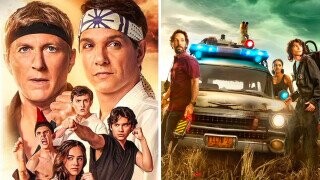How 'The Karate Kid' Franchise Outpaced 'Ghostbusters'

Despite its glaring lack of evil paintings and ghost blowjobs, the Karate Kid series isn’t so dissimilar from the Ghostbusters franchise. The two properties, which both had new entries in 2021, began way back in 1984 – yeah, instead of a soul-crushing dystopia, we got giant exploding marshmallow monsters and Ralph Macchio crane kicking bullies in the face. Suck it, Orwell.
The Karate Kid came out just two weeks after Ghostbusters in June of ‘84, and, in retrospect, both franchises have walked not entirely dissimilar pop-culture paths; both were quickly followed by inferior sequels and Saturday morning cartoon shows. Presumably, Cobra Kai will end with Daniel Larusso suffering a stroke and hallucinating the entirety of the Karate Kid animated series.
Decades later, both franchises were rebooted in the 2010s. First, there was The Karate Kid with Jackie Chan and Jaden Smith (which, weirdly, wasn’t about a kid learning karate) and later Paul Feig’s Ghostbusters. Both were straight-up remakes of the original ‘84 movies seemingly intended to launch their own canonically-distinct new film series – which didn’t happen in either case.
Don't Miss
Since our collective nostalgia is basically a Horcrux keeping most ‘80s pop-culture alive in defiance of all logic and reason, a few years after those arguably disappointing remakes, the original continuities of both series were revived in Cobra Kai –
– and Ghostbusters: Afterlife, respectively.
Arguably Cobra Kai, the acclaimed extension of the Karate Kid mythology, has surpassed Ghostbusters in finding a way to keep its story relevant in the 21st century. While last year’s Ghostbusters: Afterlife was a modest box office success, the future of the series is still very much up in the air. Cobra Kai, on the other hand, has been a massive hit for Netflix and will return for at least another season, if not more.
A big reason why Cobra Kai continues to thrive is its ability to effortlessly integrate its legacy cast with a new generation of characters. Sure, the past dominates the show, as much, if not more, than any other contemporary franchise reboot – but it’s not because a gang of scrappy youths re-discover some familiar junk – it’s the emotional weight of the past, i.e., the first three Karate Kid movies, that informs so many of the characters’ decisions, for good and for bad. And this nearly always has profound ramifications for the lives of the younger characters. By contrast, Ghostbusters: Afterlife shoehorns the senior Ghostbusters into the movie with like eight minutes to go, in perfunctory cameos that never feel grounded or real.
It’s difficult to measure exactly whether or not a movie or TV show is resonating with new audiences, but it certainly seems as though Cobra Kai has been able to lure in viewers who weren’t even alive when Hilary Swank was palling around with Mr. Miyagi. For example, real-life Dojos reportedly saw a spike in business from kids who were “inspired” to take up karate because of Cobra Kai.
Ultimately, what separates Cobra Kai so great is how, like some of the best recent reboots, it gleefully tears down the binary divisions of the original. After all, does anyone believe in the same absolutes they did more than thirty years ago? Ghostbusters: Afterlife shakes things up at the start, ditching the urban setting of its predecessors and focusing on a family rather than a gaggle of failed scientists. But they still end up restaging the events of the first movie in the third act. There’s absolutely no attempt to, as Cobra Kai did, interrogate any aspect of the original. And it’s not as if the absolutes of Ghostbusters couldn’t similarly be picked apart; the heroes are literally imprisoning the souls of deceased human beings; surely there’s another side to that story.
You (yes, you) should follow JM on Twitter!
Top Image: Columbia Pictures